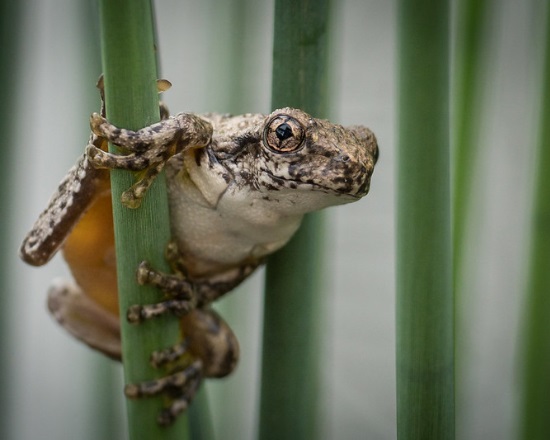What lives where in Woollahra?
Monitoring our Biodiversity
Every two years we collect data on the diversity of plants and animals found in our bushland reserves and parks. We also monitor the water quality in local creeks and waterways. We use this information to assist us with the conservation and protection of our local native species and management of waterway health.
Our most recent Environmental and Biodiversity monitoring study was conducted in late 2024.
Here are some highlights of the wildlife we found including a secretive ground bird and the fascinating fishing bat.
What’s happening with our birds?

Buff-banded Rail Image:Renee Ferster Levy
We found 26 species of native birds in our recent surveys with the diversity of birds increasing slightly across nine of our 13 sites.
This is the first year the monitoring team has spotted Buff-banded Rails (Hypotaenidia philippensis) in our area, noting them at both Trumper Park and Woollahra Golf Club. As ground-dwelling birds this species is at higher risk of predation and is rarely seen locally. These individuals appear to have survived by finding protective habitat in the thick vegetation and ponds in these reserves.
The largest owls in Australia, Powerful Owls (Ninox strenua) have also found homes here with known roosting sites in Parsley Bay Reserve and Cooper Park.
Superb Fairy Wrens (Malurus cyaneus) are amongst our smallest birds and were only spotted along the coastal fringe. These birds depend on dense shrubs and complex vegetation for protection and habitat.
What frogs can we hear?

The Peron’s Tree Frog (Litoria peronii) was the most common frog heard this year. You can listen out for males calling from high up in the trees at Cooper Park from September to December. Their call is a loud, rolling ‘brrrrrrrr’, a bit like a cackling laugh. Listen here. Other frogs that live in our area include the Striped Marsh Frog, Common Eastern Froglet and Green Tree Frog.
Where can we spot some basking lizards?

Eastern Blue Tongue Image: Doug Beckers
The rocky outcrops, fallen logs, abundant leaf litter and water sources at Gap Park and Parsley bay are attractive for several species of reptiles including the Eastern Blue-tongue Lizard (Tiliqua scincoides). These lizards can grow up to 60 cm long and of course their most unique feature is their blue tongue. Other reptiles that call our area home include the well known Eastern Water Dragon and other species of skinks.
What threatened species need our bushland?

Southern Myotis Image: Les Hall
Ecologists use a special ultrasonic detector to record the sounds of microbats in our area. In this round of monitoring we found four threatened species of bats in our area. Parsley Bay has six species of bat including the fascinating Southern Myotis (Myotis macropus), which is the only species of bat in Australia to capture fish for food. They have large feet which they use to trawl for food near the water’s surface.
The Powerful Owl (Ninox strenua) discussed earlier is another threatened species from our area.
Sunshine Wattle (Acacia terminalis subsp. Eastern Sydney) is one of our threatened plant species that is growing well following planting efforts in our bushland reserves. Care needs to be taken as they can be damaged by trampling as people and dogs create informal paths.

What other findings came from the survey?
Our larger bushland areas, such as Gap Park, Cooper Park, Trumper Park and Parsley Bay provide a greater variety of habitats, more food sources and reduced threats from predators. As these areas support the greatest diversity of plant and animal species they are important to protect. We also had notably good diversity at Woollahra Golf Club.
The quality of native vegetation has improved at most of our monitoring sites due to active regeneration activities from our staff and the dedicated efforts of our Bushcare volunteers. The most significant changes have been at our National Tree Day site at Christison Park with community planting days followed up with ongoing care from our volunteers.
Sites surrounded by vegetation reported better water quality and a higher diversity of macroinvertebrates.
What can we do to protect local wildlife?
- Create a habitat area in your garden using densely planted natives, logs, rocks and a bird bath. This type of garden will help provide habitat for small birds and support wildlife to travel through the area between our bushland reserves.
- Care for your pets. Free-roaming pets such as cats and dogs threaten our native wildlife. Check out these tips:
- For cat owners - the RPSCA have some excellent advice about how to keep your cat safe and protect native wildlife.
- For dog owners – this article from a Veterinary Science researcher provides good examples of how dogs impact wildlife and tips to control them in natural area.
- Let us know about the wildlife you've seen.
- You can report a wildlife sighting through our simple website form, noting the time, place and what you've seen.
- Join iNaturalist Australia to submit photos of animals and plants you’ve seen. The iNaturalist technology and community will help you identify the species you've spotted.
Want to learn more about local wildlife and native plants?